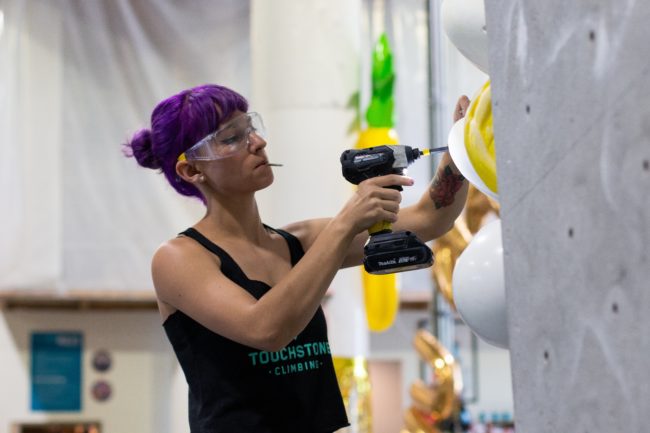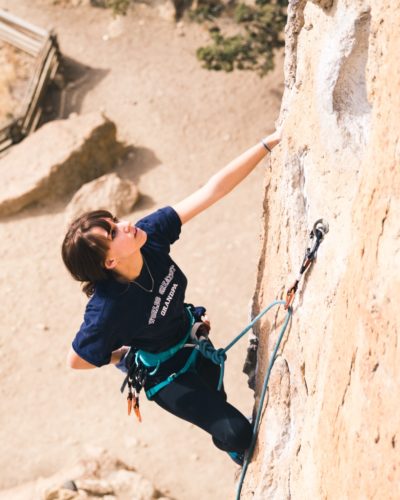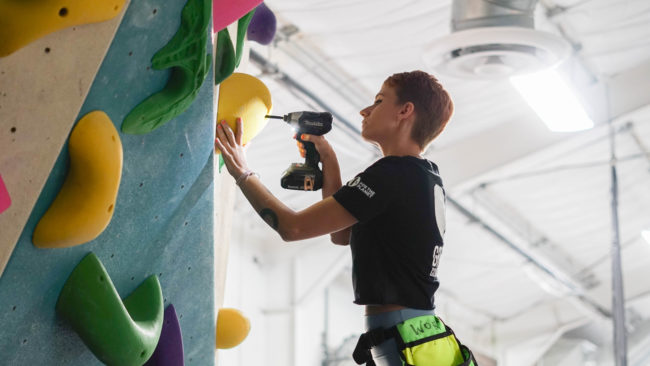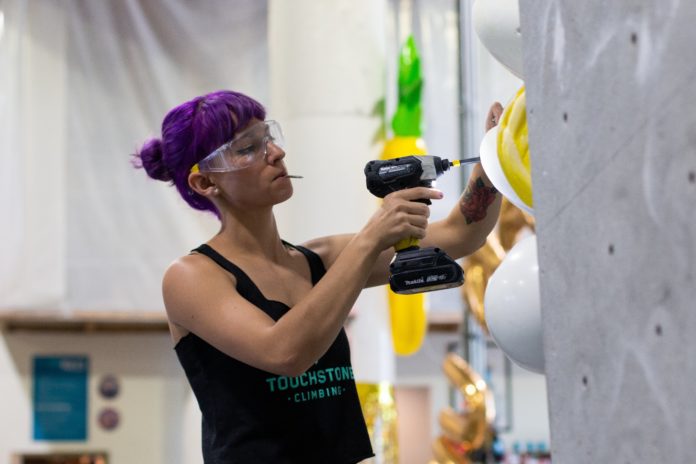Behind the Wrench…is an ongoing series that interviews the “rock stars” of the climbing industry, the routesetters at the gyms. This time CBJ heads to sunny San Diego to talk about the unique similarities of routesetting and dancing, being influenced by others, and what routesetters should really be called.

Name: Claire Miller
Home Gym: Grotto Climbing & Yoga
Location: San Diego, California
CBJ: What led you to climbing—and what led you to routesetting, specifically?
MILLER: My dad tells people that I started climbing when I was six years old, but that’s not really true. He would bring my younger sister and I to a gym after school so he could climb; my sister and I would mostly bug the front desk staff or build block sculptures in the yoga room. For a while I refused to climb indoors because I didn’t like the chalky air and the shirtless sweaty guys. That resulted in a lot of outdoor trips. The first time I lead outside I was 10 years old, and my dad’s instructions were: ‘Put this clippy end in the metal thing on the rock and the other clippy end to your rope. Make sure the rope goes the right way.’ (…What was the right way? I didn’t know!) ‘When you get to the top, stay there and belay your sister up.’
Our parents continued to take us climbing and hiking outside for most vacation and holiday breaks. I didn’t actually enjoy climbing until I was in high school, and soon after started working for Touchstone. For my 16th birthday my dad took me to get my worker’s permit so I could start working at the new Touchstone gym (Studio Climbing) that was only a mile from our house. I started as belay staff and a kids camp instructor, and I would walk to the gym after school and spend most of my time there on the weekends. When I moved to San Francisco for college, I started working at Mission Cliffs. There I headed the kid’s camp program and started coaching the youth teams. It wasn’t until I graduated and moved back to San Jose that I started routesetting. When I first started at 16, I never would’ve thought I’d become a routesetter. But looking back on my time with Touchstone, I can see the path that I unintentionally took to get to routesetting. I think the moment that sparked the idea—the ‘Oh, maybe I can do this!’— was right before I left San Francisco. I mentioned that I was moving back to San Jose to my friend and Touchstone NorCal head setter, Buck Yedor, and he said, ‘Hey do you want to set down there?’ I laughed and said no way. Two months later I started setting.

I recently moved to San Diego where I started working for Grotto Climbing & Yoga as a coach and routesetter. While my boyfriend and I were looking for apartments in San Diego, we decided to take a break [from the search] and visit a gym. Our first visit at Grotto, I met the general manager and head setter. Their energy and love for their gym sold me, and I asked if they were in need of any setters. I guess the feeling was mutual. Grotto is awesome and so fun to work for. My responsibilities are so different from where I was before. I am lucky to have come from such a supportive and engaging crew [at Touchstone]; they taught me everything I needed to know and more. The foundation I built with them prepared me for where I am today.
CBJ: Are there any skills, interests, or aptitudes outside of climbing that you think have helped you hone your setting skills? In other words, any unique interests that you think influence your setting?
MILLER: That’s a difficult question to answer. I wasn’t involved in a lot of sports as a kid. I tried track and field, tried volleyball, and tried swimming. The only activities that lasted more than one season were dance and climbing. Maybe dancing has influenced my setting, but I thought that delicate-balancy movement was just my style. I know for sure that dancing and climbing for as long as I have has helped me understand body awareness and movement on and off the wall. It wasn’t until I started coaching that I was able to articulate the why and how behind movement. Even with my background, transitioning to the world of routesetting wasn’t as smooth as I thought it was going to be. In the beginning I relied very much on feedback and advice from my setting crew. I had to be told multiple times to trust myself, that I knew what I was doing—even though it didn’t feel like it. Every setter that ever helped me when I was learning has influenced my setting. Sometimes while setting, I’ll find myself doing something that makes me pause and think, ‘Oh wow, so-and-so would totally do this,’ or, ‘This is such a so-and-so move.’
CBJ: How has routesetting—either the methodology of the craft, or the business-side and the career aspect—changed at all since you started? And has it ever been challenging to adapt to any changes?
MILLER: I feel like routesetting is different to whoever you talk to or wherever you go and it changes constantly. I especially noticed a huge difference when moving from Touchstone to Grotto. With Touchstone, you could have a career with routesetting, you could set full-time—every day of the week if you wanted—because the demand was there. At Grotto, routesetting full-time was not an option; I had to start coaching. Granted, I love coaching and I think I am a good coach. But that has been challenging for me because I love routesetting and want to do it every day. Now that I can’t set every day, it makes me appreciate it so much more.
CBJ: Do you have any strange or unique setting stories? There was that recent incident at Toulouse where Jernej Kruder ripped a volume off the lead wall—I suppose that’s a really dangerous anecdote, but definitely something that sticks in people’s minds about routesetting. Maybe you haven’t had anything in that (dangerous) sense that has happened, but just…anything that sticks out in your memory as a fun or quirky incident?
MILLER: Oh man, I don’t have anything as exciting as that… luckily? I guess all my stories are pretty boring compared to that. One memory in particular sticks out because I never got paid. My coworker challenged me to set a boulder using only five morph volumes for a dollar. I did—and no dollar was awarded. I’ll never forget. The great thing about that boulder was adults had a really hard time with it. It was only rated V5, but the only people who could climb it comfortably were the team kids.

Another incident that sticks out was when I was climbing with my boyfriend. I had him guess who set what, and which climbs were his favorite. He didn’t choose any of mine. It makes sense to me though, him being 6 feet 2 inches tall and me being 5 feet 4 inches, we rarely like the same climbs. But when I play that game with my dad (5 feet 11 inches) he always likes my climbs. Unintentional family bais maybe.
CBJ: If you had to give your five biggest tips for setting great routes, what would they be?
MILLER: The tips that I live by, and I have to remind myself of on a daily basis, are little snippets of wisdom I’ve collected from the routesetters I look up too.
First, trust your instinct; when your mind is cluttered with ideas, go back to your first. Don’t go down the rabbit hole.
Second, don’t be afraid to ask for a second opinion. It’s important to trust yourself but you’re not the best.
Third, it isn’t a beauty contest. A boulder doesn’t have to look good to climb well. Don’t focus on aesthetics.
Fourth, you don’t have to climb V10 to set V10, but it does help. People are often shocked when I tell them I can’t complete a boulder that I set. I tell them that’s one of the secrets of routesetting, knowing what makes a hard climb hard without having to climb hard.
Lastly, you can’t always set gems. Everybody, even the best routesetters, have off days.
CBJ: If/when you are feeling some burnout, what do you do to get over it? I think that’s something that all gym employees struggle with, but it’s a particularly hefty thing with routesetters since the job is, by nature, so physically demanding and exhausting (and mentally challenging!)
MILLER: I sort of have two approaches to routesetting while feeling burnt out. Sometimes I will challenge myself to ‘channel’ a setter that I admire. I’ll try to set a boulder in their ‘style,’ as best I can. Usually I end up not being satisfied with the boulder, but that’s OK because I didn’t set it!
My other approach, and this is a little embarrassing, is to space out and let the ‘setting gods’ take over. This is usually just following instincts and choosing holds and moves that I’m psyched on. I’ve found this approach works better when setting routes rather than boulders because it’s easier to space out when you’re dangling on a rope. I promise I’m being safe while using this approach.

CBJ: If we consider setting to be an art, that means it will always evolve. Setting in 20 years will look quite different than setting in the present day, just like movies and music from 20 years ago seem quite different. So how do you see routesetting evolving in the future? 10 years? 20 years?
MILLER: Routesetting definitely is an art! We should call ourselves route ‘designers’ honestly. I think as routesetting evolves, there will be more division in routesetting styles/’genres.’ For example, right now I think there is a dividing line between setting commercially and setting for competitions. I think as time goes on there will probably be divisions in those divisions. I have no idea where it’s going to go or what these divisions will be. Climbing, as a sport, and routesetting, as an art, have so much more room for complexity than other sports do. Everything is going to get a lot more complicated. I don’t think any style of routesetting will ever become irrelevant. Artists always refer back to the classics for foundation.
Got a cool story? Tell us!
Do you know a routesetter in the climbing industry who would be good to profile in a Behind the Wrench segment? (Or, are you a routesetter and have a personal background that you think others would enjoy learning about?) If so, please contact us and tell us about it!

John Burgman is the author of High Drama, a book that chronicles the history of American competition climbing. He is a Fulbright journalism grant recipient and a former magazine editor. He holds a master’s degree from New York University and bachelor’s degree from Miami University. In addition to writing, he coaches a youth bouldering team. Follow him on Twitter @John_Burgman and Instagram @jbclimbs. Read our interview Meet John Burgman, U.S. Comp Climbing’s Top Journalist.









